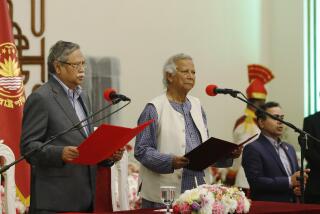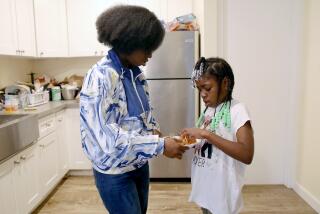Microcredit Bank Grows Out of a $27 Investment
- Share via
DHAKA, Bangladesh — The father of a banking revolution that has helped millions of poor people says his “eureka moment” came while chatting with a shy woman weaving bamboo stools with calloused fingers.
Sufia Begum was a 21-year-old mother of three when economics professor Muhammad Yunus met her in 1974 and asked how much she earned.
She said she borrowed 5 taka, about 9 cents, from a middleman for the bamboo for each stool.
After repaying the debt, she was left with 2 cents for each stool.
“I thought to myself, my god, for 5 takas, she has become a slave,” Yunus said.
That epiphany ultimately led to something called microcredit and the Grameen Bank, which has granted $4.18 billion in small loans to 3.12 million Bangladeshis. A model for microcredit financing in 65 developing countries, the system has helped about 17 million borrowers worldwide and pledges to eventually lift 100 million people out of poverty.
In essence, one man from one isolated and blighted country helped millions with just $27.
Not everyone sees microcredit as an unalloyed success. Some economists at home and abroad say that its claimed 99% loan recovery rate is an exaggeration, and complain that Grameen’s interest rates are too high.
Still, when more than 1,000 microcredit proponents recently gathered to take stock of the movement in Dhaka, the Bangladesh capital, the star attraction was Yunus, the man former President Bill Clinton once said deserved a Nobel Prize.
Queen Sofia of Spain, honorary chairwoman of the Washington-based Microcredit Summit Campaign, called Yunus the “pioneer of this great and already universal achievement.”
In 1974, Bangladesh was a newborn nation, ravaged by war and famine. Yunus, then 33, had returned two years earlier with his American wife, leaving behind a comfortable life in the United States.
With a PhD in economics from Vanderbilt University, he became the head of the economics department at Chittagong University on the Bay of Bengal. But he felt foolish pontificating in the classroom as people starved just outside the campus, in the city where he was born to a middle-class jeweler.
“There I was, teaching all these elegant theories in the classroom while out in the streets, I saw these people going hungry,” Yunus said.
Yunus told his students to follow him to the nearby village of Jobra to study economics from the ground up. The first person he stumbled on was the young woman weaving bamboo stools.
“I couldn’t understand how she could be so poor when she was making such beautiful things,” he said. He was determined to teach her to help herself, although not quite sure how.
The next day, the students did a survey and discovered that 42 villagers in Jobra owed a total of 856 taka, about $27.
“I couldn’t take it anymore. I put the $27 out there and told them they could liberate themselves” and pay him back whenever they could, he said. The idea was to buy their own materials and cut out the middleman.
They all paid him back, day by day, over a year.
“They were so excited and I thought, if you can make so many people so happy with so little money -- why not make more people happy with a little more money?”
Yunus drove his white Volkswagen Beetle to the state-run Janata Bank to apply for a loan. After months of negotiations, the bank loaned him enough to replicate the Jobra experiment in 100 more villages.
All those loans were paid back as well. Encouraged, Yunus won government approval in 1983 to open Grameen, Bengali for “rural.”
Today 1,194 Grameen Bank branches serve 43,500 villages, or 60% of rural Bangladesh. Loans average $200 per borrower.
This in a country that Henry Kissinger once dubbed “South Asia’s basket case.”
The globe’s most densely populated country -- 140 million people sandwiched into an area the size of Iowa -- staggers under 36% unemployment and an average income of a dollar a day. More than 70% of its people have no electricity or safe drinking water.
Yunus and his wife divorced; she returned to the United States with their daughter, Monica, now a soprano with the Metropolitan Opera. Yunus remarried, to a Bangladeshi physics professor, and they have a teenage daughter.
Yunus is 63 now, handsome with a head of thick gray hair and wearing a traditional cotton tunic. He says his mother imbued him with compassion for the poor. She had 14 children, nine of whom survived, and she would sock away pocket change for needy neighbors.
He has enormous faith in women. They are more than 95% of Grameen’s borrowers, they make their payments on time and they put their profits back into the family, he said.
He was speaking during a visit to Kashipur, a village of rice paddies just north of Dhaka, where water buffalo lumber down dirt paths alongside a woman speaking Bengali on a mobile phone.
About 45 women in well-worn saris surrounded him, treating him like a celebrity. They sat on benches in a tin-roofed shack with hard mud floors and reported on projects, told him stories, laughed and cheered. One complained that her cow was sick; another said she missed her son, a construction worker in Saudi Arabia.
The women feel at ease with Yunus, not that common in this conservative Muslim country where rural women take a backseat to men, especially their husbands.
“The first hostile person to our program is the husband. He hates us.... We are challenging his authority,” Yunus said.
“So we bring all the husbands together. In the family, he’s a macho tyrant. But you get them in a group and they become very docile,” Yunus said.
“He starts to see that she’s not as stupid as he thought. He says, ‘Now she cannot nag me about money, because she understands now how hard it is to make.’ The tension eases and they become a team.”
To become a part of Grameen, a borrower must belong to a group of at least five. First, two are given loans and only when they have made their payments six weeks running are the others eligible for loans. None is liable for the other’s debt, but Grameen believes that the collective responsibility serves as collateral.
In Kashipur, the barefoot women line up to hand the local Grameen representative small wads of cash. After 17 years with the bank, they have 100% repayment.
Some have borrowed to buy another cow or expand their rice paddies or mustard fields. Four women bought cellular phones and walk about the phone-less village, making and taking calls for a small fee.
“Mr. Yunus has done more for the poor people of Bangladesh than anything our government has ever done,” said Anju Monwara, a “telephone lady.”
Not everyone is so taken with Yunus or his bank.
The critical economists say that small loans get vulnerable women hooked on credit and that the system does little to eradicate poverty.
“Microcredit has many flaws,” said M. M. Akash, an economics professor at Dhaka University. It does not reach the extreme poor, who account for 20% of the population, he said. They have no homestead or land to cultivate and fear banking and investment.
Grameen does not require borrowers to have collateral. But the interest rates can run from zero for beggars -- what Grameen calls “struggling members” -- to 5% on a student loan and 20% for an income-generating loan to a small business.
Yunus said that was the price one paid to run Grameen free of donor debt from the Big Brothers of globalization, such as the World Bank. Aside from the 7% of the bank owned by the government, the borrowers of Grameen own all the equity.
Yunus believes that there should be a body that monitors and regulates globalization, similar to what the United Nations does for world order and security. “You know, keep the big trucks on the fast lane, but create a small path for the rickshaws.”
Associated Press correspondents Farid Hossain and Parveen Ahmed in Dhaka contributed to this report.
More to Read
Inside the business of entertainment
The Wide Shot brings you news, analysis and insights on everything from streaming wars to production — and what it all means for the future.
You may occasionally receive promotional content from the Los Angeles Times.










